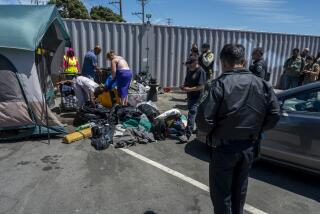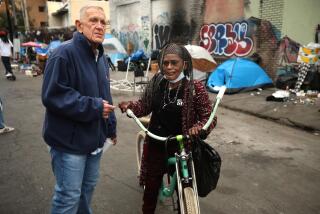Helping Homeless Help Themselves : San Diego: The Neil Good Day Center offers no cots, food or handouts. It offers street people something else: Hope through empowerment, dignity and jobs.
- Share via
SAN DIEGO — The last thing the Neil Good Day Center wants to be seen as is just another shelter for the homeless.
The center--which is the model for a similar facility that Los Angeles Mayor Richard Riordan wants to build in Downtown--is driven by a philosophy of offering hope to the hopeless, by taking tough stances toward the people whose lives it aims to turn around.
For that reason, it offers no sleeping cots or food to the homeless. But it is a place where street people can come during the day to take a shower, do their laundry, sleep on a lawn beneath a tree, or maybe take a step toward gainful employment.
“If I give a guy a sandwich and I know that he is slamming drugs all night, all I’m doing is helping to kill him,” said Bob McElroy, the former drug addict and panhandler whose Alpha Project runs the center under a contract with San Diego.
“I’m about creating jobs,” said McElroy, a former Bible student, whose early work with the homeless included passing out sandwiches in a San Diego park. “We’re into empowering these people out here to take control of their own lives. You give me rakes, shovels and weed whackers, and you get dignity, self-respect, value, earning potential, hope.”
McElroy said he supports efforts in several cities to crack down on the homeless, saying “amen” to ordinances aimed at controlling homeless populations. “Guys out there on the floor will tell you the same thing,” he said, gesturing toward the Good Center’s day room.
Thomas E. Suggs, a homeless man who sat reading a book, agreed. If he were a business owner, Suggs said, “I wouldn’t want the homeless hanging around. They are an eyesore, a deterrent to customers.”
More stringent city ordinances could be “an incentive for some people to get . . . off the street,” McElroy said. “These people are survivors. Why are there panhandlers? Because people give them money. If nobody gave money to the panhandlers, there wouldn’t be any panhandlers.”
If he had the power, McElroy said, “there wouldn’t be one food line, one feeding center, one drop-in shelter with a cot, one program that I could check into for 90 days at my own discretion and come and go as I please with no requirement placed upon me.”
By eliminating those services, he said, homeless people “would have to come to me with a serious attitude and say: ‘I’m really hungry and I want to earn my sandwich, earn my bed, earn my way out of here.’ ”
As McElroy sees it, people who set policy never talk to the homeless.
“These people got so many smarts out here,” he said. “They designed our whole program--told us the right and wrong things to do.”
San Diego’s City Council chose McElroy’s Alpha Project to run the center after the contract was turned down by the Episcopal Community Services because officials thought the city was not committed to sufficiently funding the project.
McElroy grabbed the opportunity and soon organized homeless people into work details doing landscaping, tree-trimming, painting and graffiti removal for a variety of paying customers.
McElroy said his Alpha Project put 120 homeless people to work building the Kansas City Steak House in San Diego, one of the city’s largest restaurants. More than 80 of those people went on to full-time jobs in the private sector, he said.
He is now trying to raise about $800,000 to fund a jobs program for homeless workers to control litter and clean up the Logan Heights area of San Diego where most programs for the homeless are concentrated.
The center has caught the eye of Los Angeles officials struggling to cope with the ever-increasing problem of urban homelessness. A City Council committee Monday will consider a proposal from the mayor’s office to develop a similar facility in an industrial area east of Downtown.
The L.A. Center would be open 24 hours, with 50 beds and, like the Neil Good Center, a lawn for homeless who prefer outdoor accommodations to sleeping inside. Three locations that would be financed by federal funds are under consideration, James said.
Advocates for the homeless have criticized the proposal, calling it a transparent scheme to put the unsightly throngs in Downtown out of the sight of tourists, shoppers and businesses.
McElroy does not argue with that assessment. That is exactly what the San Diego center was designed to do, he said.
But if city officials in Los Angeles are looking at the center as a way to get the growing number of homeless out of sight, McElroy has one caution: “It won’t work.”
Four hundred homeless people come through the San Diego center each day, he said, but that still leaves 2,500 in the city’s downtown business district.
“The center was supposed to be a magnet to draw the homeless out of downtown,” he said. The “proof of that pudding,” he said, is that the center was originally designed to be open only five days a week because “all of the business people go home on the weekends. So it’s OK for the place to be closed.”
McElroy focused press attention on the five-day plan, and was able to persuade officials to open the center for seven days.
The Neil Good Center is composed of a 5,000-square-foot building and a similar sized patio and lawn. Funding came from the city and county governments, the San Diego Unified Port District and the city’s redevelopment agency. The center has a budget of $177,000 a year, and serves about 400 people a day.
And it has been far from free of controversy.
The City Council is debating whether social service agencies in the eastern section of downtown serve only to concentrate the homeless. San Diego City Councilman Juan Vargas was one of the early critics, but he has become a supporter of the center’s emphasis on trying to put people to work.
One morning last week, several dozen homeless people were in the center by 8 a.m., doing laundry, showering, picking up mail and looking over classifieds. Regulars found their partners for bid whist, pinochle and chess. Others simply took a load off, sitting and resting in the center’s reading area.
Outside, more than a dozen people slept on the ground in the warm sun, their shopping carts parked in a row nearby. Several people standing in a courtyard agreed that the center is a badly needed facility for people who have nowhere else to go.
For others, it is a respite from the rigors of the streets.
“I mostly want to come here when I want to read a good book,” said Jim Jackson, 32, a former commercial artist and self-described alcoholic. Reading, he said, “is the only entertainment I have right now.”
When Los Angeles city officials spent two days at the center, McElroy said, his constant message was “work, work. Give these people some hope. Give them the opportunity to take back Skid Row, to build houses.”
An idea suddenly hit him: “Maybe Alpha Project will go up to Los Angeles and apply to run that program.”
More to Read
Sign up for Essential California
The most important California stories and recommendations in your inbox every morning.
You may occasionally receive promotional content from the Los Angeles Times.






